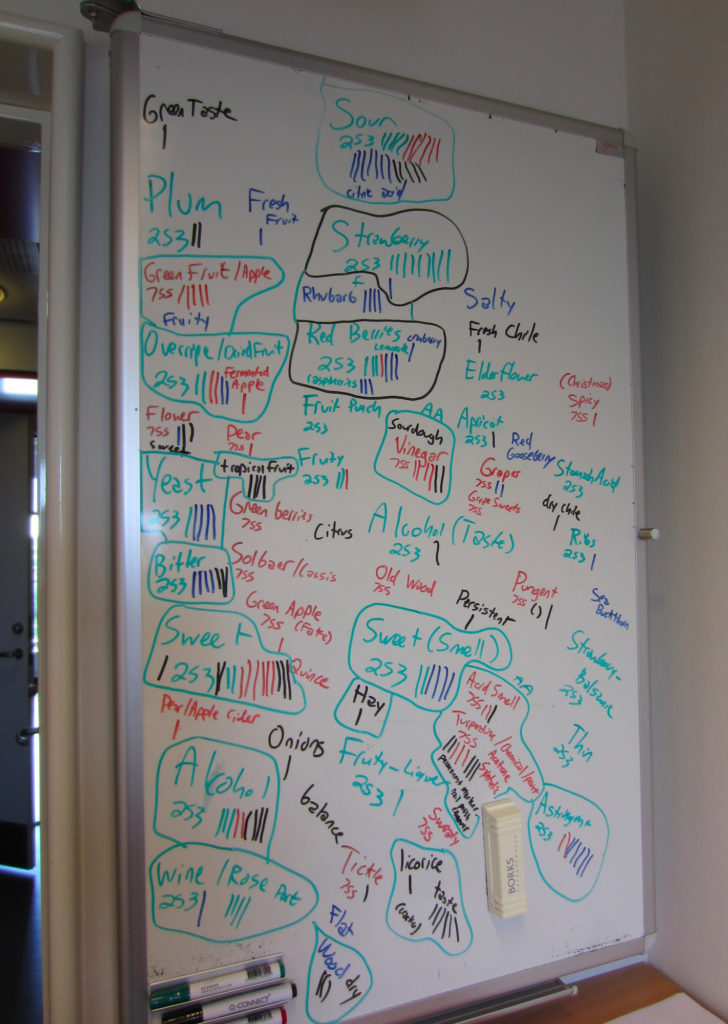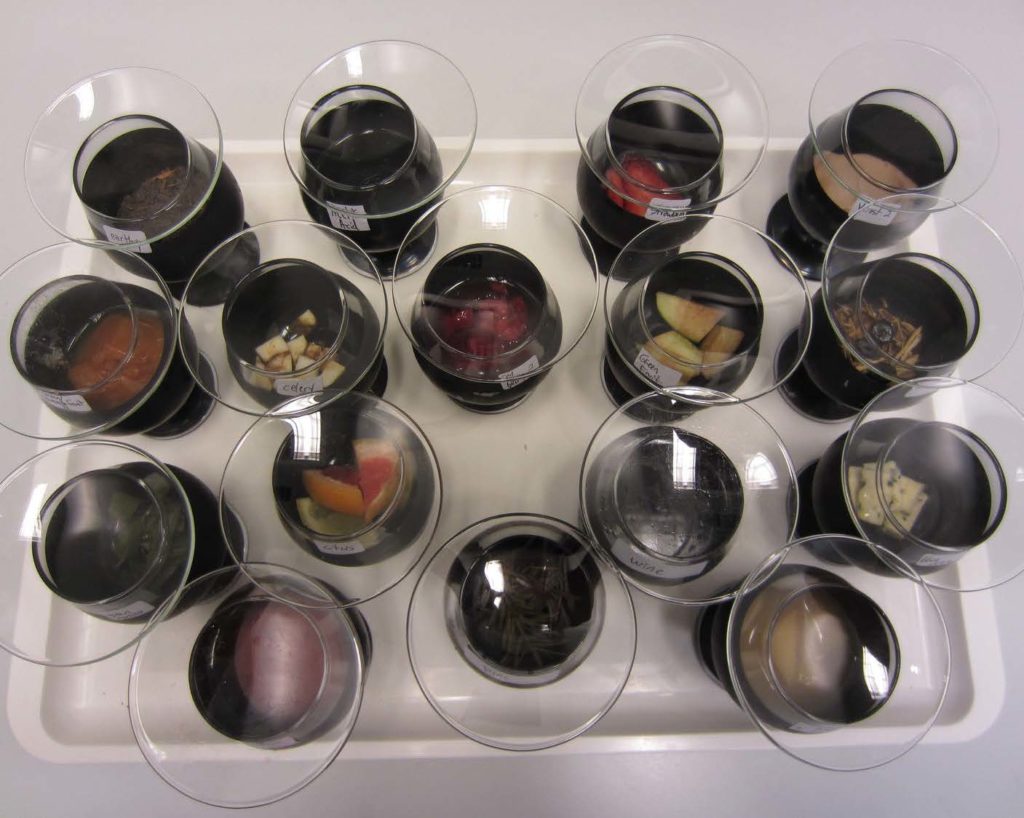by Arielle Johnson
Overview
With all of these techniques being put to the test, comparison is needed to to determine whether the different vinegars are interesting enough for future elaboration. In this third instalment of our 5-part miniseries on vinegar science, we detail the process of sensory analysis – including assembling a trained human panel, generating flavour descriptors, identifying reference standards, and conducting replicate sets of tests – that we used to qualify their specific characteristics and perhaps to reveal which processes had led to a tastier result. Overall, it seemed that the vinegars that had ended with some residual sugar and had undergone more stages of fermentation yielded tastier vinegars.
While we taste all our experiments carefully and mindfully, we decided for this vinegar-investigating project to use descriptive analysis to profile the flavours of the vinegars. This meant that we could get some hard data to work with, and also explore how best to incorporate sensory analysis techniques into our ongoing research and development. We performed descriptive analysis on our vinegars at the University of Copenhagen (KU) Faculty of Life Sciences in Frederiksberg, with the help of a trained panel of ten volunteers from the food science department. The goal of this analysis was to pinpoint specific flavours, fix their definitions to real references, and determine the intensity of each flavour in a set of products.
The key components of a descriptive analysis are:
– The samples in the experimental set: Are they very similar or very different from each other? Small differences will be more difficult to detect but may yield more specific and less obvious information about flavour. Our samples were somewhat similar as they are all vinegars, with many of their flavour differences coming simply from differences in their primary ingredients.
– The panel: Human beings used as analytical instruments, reporting on what flavours are present and at what intensities.
– Flavour descriptor generation: The panel is both the tool and the process by which sensory analysis determines what flavours are present and prominent in a set of samples. This begins with panelists tasting the samples blind, thinking about what they perceive, and discussing them with each other, which leads us to:
– Terms and references: For every flavour the panel says they perceive, it is our job to create a reference that captures a consensus definition for each aroma. For example, when a panelists says “citrus”, does she mean lemon peel or orange peel? Or something that only exists as a mixture of different fruits? We need to figure out the ideal combination that will then serve as a reference standard to keep all panelists based in a shared olfactory vocabulary.

Along with the taste descriptors sweet, sour, salty, bitter, and umami, we narrowed the list of flavours down to “red berry”, “strawberry”, “acetic acid”, “rotten fruit”, “chemical”, “green apple”, “liquorice”, “yeast”, “wine”, “tropical fruit”, “rhubarb”, “celery”, “earthy”, “green vegetable”, “citrus”, “pine”, and “blue cheese”. Creating references for some of these were pretty straightforward. Everyone agreed that the descriptor “strawberry” was perfectly captured by a ripe strawberry, cut in half. But what about less precise terms? Rotten fruit – according to the panelists – did not smell like a fully rotten apple, but was more oxidized and fermented than just a bruised apple. Cubed, bruised, and yeast-sprinkled apples and pears, left to sit on a counter for a day, we finally agreed, captured the aroma the best.
Dry yeast was too weak for the panel, but a cube of fresh yeast was perfect (since Danes tend to use this variety for baking, it was likely more familiar to our local panelists). For “red berry”, which the panel insisted was different from strawberry, neither red currants nor raspberries alone were quite right, but satisfied when combined together. The “chemical” aroma the panel was picking up on was probably ethyl acetate, a common by-product of vinegar fermentation formed from the reaction of ethyl alcohol and acetic acid; for this, nail polish remover was a good match. For “pine” and “earthy” references I gathered samples from the Assistens cemetery in Nørrebrø. Who knows, maybe they imparted a few molecules of Hans Christian Andersen, who is buried there, for good luck.

With the references prepared and agreed upon, we began the descriptive analysis proper. For 3 days in a row, the panelists smelled the references to reacquaint themselves with each aroma and its specific descriptor, and then went into isolation booths, where they smelled and tasted each of the vinegars and then rated the intensity of each of the reference flavours in the samples.
These pooled intensity ratings make up the flavour profile data we use to analyze the sensory characteristics of the vinegars. Certain statistical techniques we apply to this data determine which flavours are most useful for distinguishing samples from each other, while other techniques look at the sensory data holistically, and compare it to the flavour-active molecules present in each vinegar, to describe the sensory and molecular drivers of flavour across the dataset as a whole. This analysis will be made available in a forthcoming journal paper.
The sensory and chemical analyses we performed on our vinegars give us a glimpse into how their component flavours interact. By continuing to borrow analytical techniques from academic sensory and flavour chemistry labs, we look forward to building a molecular intuition about flavour to complement the intuition of our palates. But when it comes to the answers we seek, and their questions, the scientific process will only reveal so much.
To fully understand food, we need also to listen to our palates in more aesthetic, less quantitative ways. For example, some of us around the lab, and some of the panelists, talked about differences in balance, complexity, and depth of flavour, which are difficult to measure analytically. We can develop our culinary empiricism to deal with these ideas faster and better not only by taking into account whatever hard data we might have, but also by contemplating and making decisions on the most compelling directions to pursue using our own senses.
Many of the most interesting questions that arose while we developed our vinegars had little to do with naturalist, analytical ideas of underlying flavour chemistry and more to do with practical concerns about what we can do with these ingredients, the best ways to work with them, and how to make products that are new and interesting and better than what we already have.
For example, it seemed like some of the tastier vinegars were more complex and had gone through multiple fermentations (for instance, a yeast fermentation followed by an acetic fermentation). On a molecular level, this theory makes sense: each fermentation step will generate more and different volatile molecules as by-products, leading to a greater potential pool of flavours. Furthermore, starting from a sugary mixture and fermenting it into alcohol with yeast means that some residual sugar might be left over – balancing some of the acid, giving a bit of body, and improving the overall flavour.
At the same time, some of the tea-based vinegars had interesting flavour potential but at times seemed to lack complexity. We also wondered if the air-pump approach to running the acetic fermentation – which was especially good for rapid prototyping as it produced workable vinegars in under a week – led to any flavour differences, good or bad, compared to a slower, passive fermentation over the course of months.
Next up: Slowing down the process, and expanding from wine to beer.
